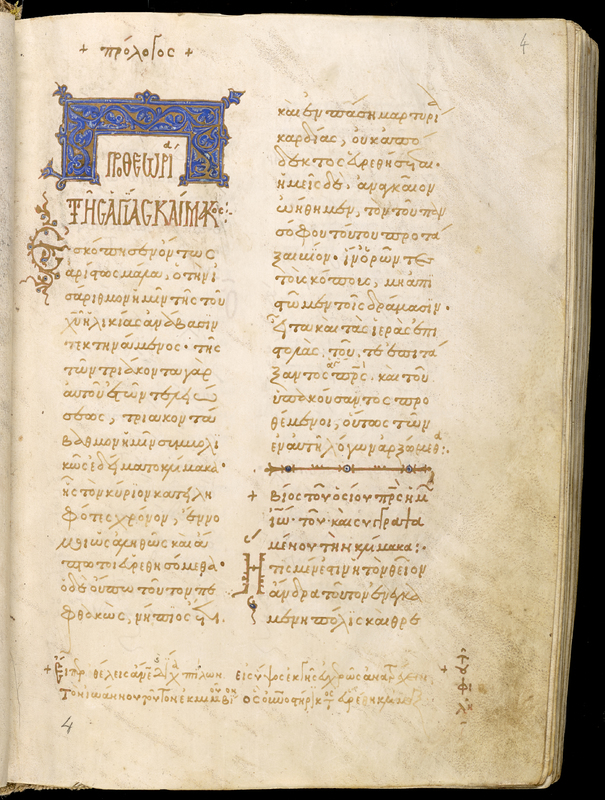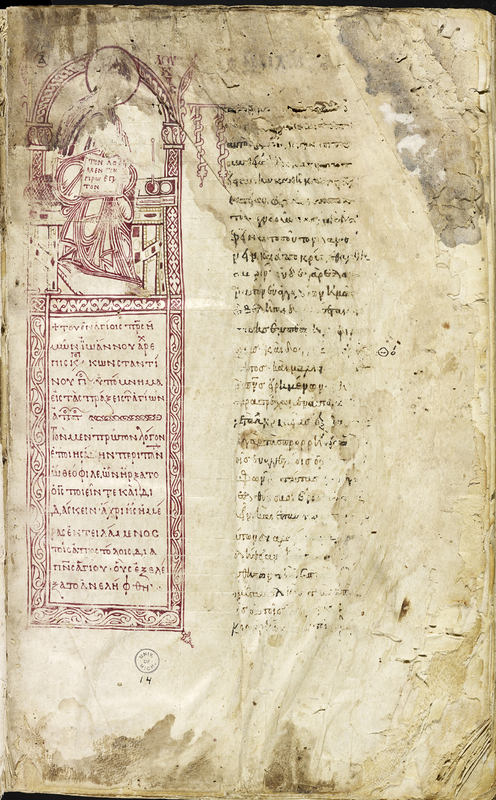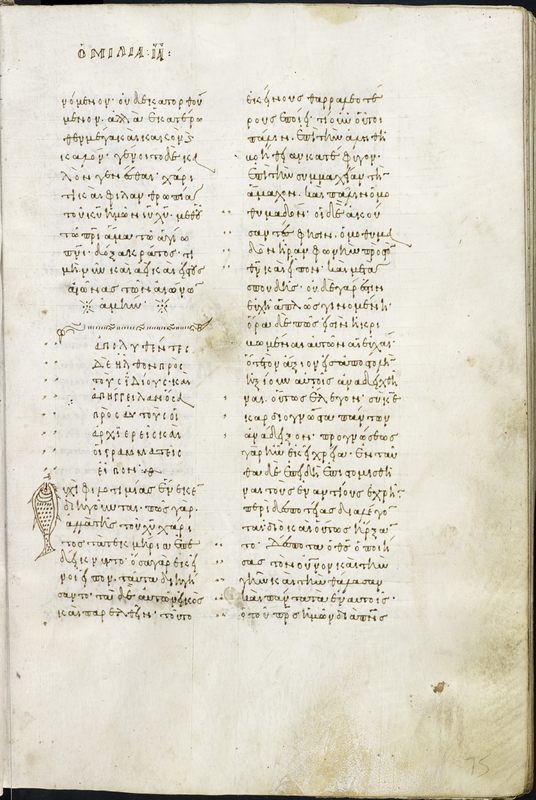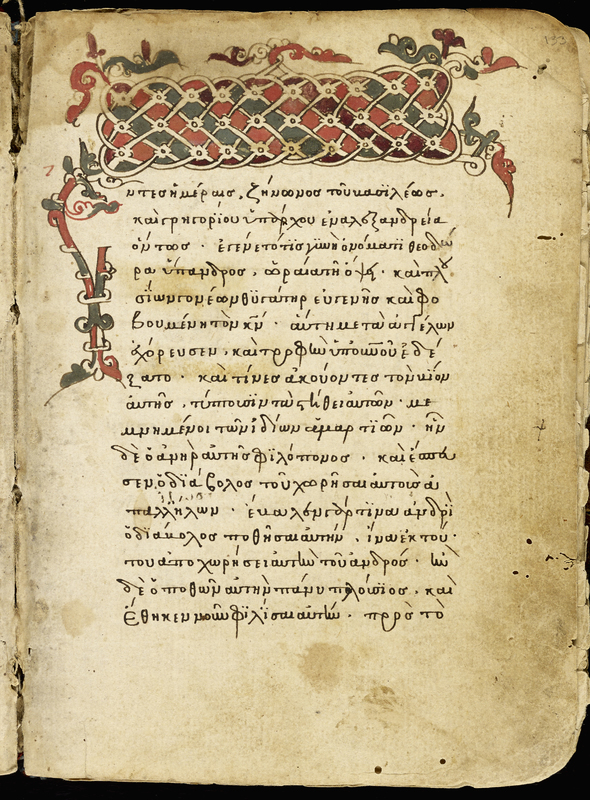The Saints
A saint is a holy (ἅγιος) individual, a powerful designation given to Christians who show their intimate connection to the divine world by the example of their deaths (martyrdom) or the actions of their lives.
Saints belonged to all orders of life, from emperors to hermits, farmers, and slaves, and some of them were accomplished scholars who made important contributions to shape Christian theology, including figures like Basil the Great (ca. 329-379) and John Chrysostom (ca. 340-407). The ecclesiatical authorities encouraged the veneration of saints by several means: hymns and biographies were written in their honor, their deaths were commemorated by establishing feastdays in the Church calendar, and readings from their lives were incorporated in the liturgy.
This section features three manuscripts containing texts by prominent saints in the history of the Christian Church. The first manuscript (Mich. Ms. 134) contains works by John Klimax (ca. 579-ca. 650); next is one of the most important manuscripts in our collection (Mich. Ms. 14), an early witness of the Homilies on the Acts by John Chrysostom; and lastly is a collection about the lives of female saints (Mich. Ms. 50).
See above fol. 13v from Mich. Ms. 134, a full-page illumination showing the Heavenly Ladder, representing monks, aided by angels, ascending the ladder towards Christ in Heaven. The monks who fall off the ladder are sinners who were unable to follow the stages of ascetic life prescribed by the author of the text, John Klimax.
The text of Mich. Ms. 134 was authored by the theologian and saint John Klimax (ca. 579-ca. 650). His major work, The Heavenly Ladder, encapsulates the experiences of the so-called desert fathers (the early ascetics of Egypt), whose sayings, mostly based on their ascetic lives, were recorded in book form: Apophthegmata Patrum (Sayings of the Fathers).
See above fol. 4r from Mich. Ms. 134, the beginning of the prologue prior to the Life of John Klimax. Note the pi-shaped decorated headpiece in blue and gold. The manuscript is elegantly illuminated in blue and gold and in red and gold.
The scribe of this manuscript has been identified as the famous calligrapher Ioasaph II of the Hodegon Monastery in Constantinople, whose career spans from 1360 to 1406 CE. Ioasaph introduced a distinctive calligraphic variety to the Hogedon style, which imitated eleventh-century Perlschrift, by adding a “baroque” mannerism.
Above is fol. 1r from Mich. Ms. 14. The manuscript begins with a portrait of St. Luke, who was believed to be the author of the Acts. Drawn in magenta ink, the portrait is surrounded by a wide frame, whose upper part has the shape of an arc supported by two Corinthian columns. The frame is decorated with geometric and interlace motifs.
Luke is depicted seated on a red cushion, which is placed on a bench decorated with a geometric design. He holds an open book with the beginning of the text that is included below, the title of the first homily written in red ink in Alexandrian majuscules, which are surrounded by a red frame decorated with a rinceau design. On the right side of the bench is a small desk with two inkpots, one of them with red ink, and a pen.
Notice the first initial pi executed in red ink, with its vertical strokes decorated with entwined strips.
The page on display above, fol. 75r from Mich. Ms. 14, shows the beginning of John Chrysostom’s Homily 11. Note the initial omicron in the shape of a fish.
The titles of the homilies are written in vertical Alexandrian majuscules, and the main text in early minuscule. The minuscule script has features of the writing styles of the ninth and first half of the tenth centuries: the oblong ancient minuscule and the minuscule bouletée élancée. The script is medium size and vertical with many elongated strokes. Whereas the decorated first initial pi is written in red, all the other major initials are in the ink of the text, being either undecorated or simply decorated with knots, dangling fruit, geometric patterns, and occasionally with zoomorphic motifs, like the initial omicron.
The manuscript was probably produced at the end of the ninth or the first quarter of the tenth century, most likely in Constantinople. The manuscript was purchased by the University of Michigan from the antiquarian dealer Wilfrid M. Voynich in May 1922.
The image above, of fol. 12r from Mich. Ms. 50, shows the headpiece introducing the Life and Conduct of St. Mary who Changed her Name to Marinos.
Note the interlace ornamentation of this headpiece, executed in the ink of the text. It's filled with bright red, dark green, and burgundy pigments. This headpiece is also adorned with large finials in the shape of palmettes. In the manuscript, two other rectangular headpieces and one endpiece are extant from an unknown number.
Mich. Ms. 50 contains a series about the lives of female saints, each of them celebrated for their exemplary lives and deaths. The script is small and neat. It's a professional archaizing minuscule from the end of the fourteenth century.
See above fol. 133r from Mich. Ms. 50. Note the interlace headpiece introducing the Life and Conduct of St. Theodora of Alexandria.
According to the colophon on fol. 149v, the manuscript was executed in 1395/1395 CE at the expense of a priest called Nikolaos. According to Annaclara Cataldi Palau, the manuscript was copied in Epiros, probably for a women’s monastery (nunnery).
The manuscript belonged to Baroness Burdett-Coutts (s. n. in her collection). It was acquired by the University of Michigan at the Burdett-Coutts sale in May 1922. Sotheby, Wilkinson and Hodge, The Burdett Coutts Library, lot 221.

The Liturgy

The Monasteries






